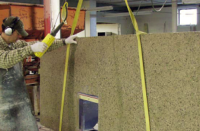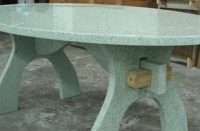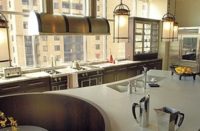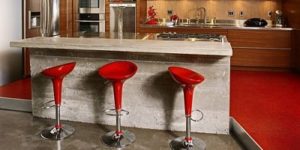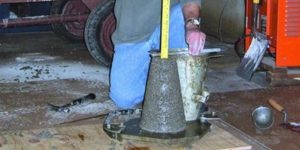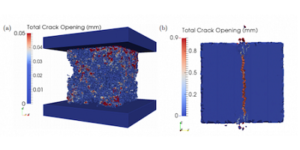Are you new to countertops? Are you confused about what the term “wet-cast” means? Here’s a look at fluid concrete mixes for wet-casting as compared to stiff mixes for hand-packing, which is also known as “the Buddy Rhodes method.”
Stiff Mix
 A stiff concrete mix is characterized by its zero-slump, stiff plastic state. The fresh concrete is easy to mold. It typically uses an all-sand mix design.
A stiff concrete mix is characterized by its zero-slump, stiff plastic state. The fresh concrete is easy to mold. It typically uses an all-sand mix design.
Pros
- Almost all styles of concrete are possible: uniform, terrazzo, veined, etc.
- Forms do not need to be watertight. Caulking is not necessary.
- Complex shapes using simple forms are possible.
- Reinforcing steel stays where it is put.
- Ghosting is significantly reduced or eliminated.
- Final product is very natural in appearance.
- Can control surface void shape and size.
- A wide range of stiffness and plasticity is possible.
- Screeding and troweling can be performed soon after casting.
- No bleed water.
- Casting tables do not need to be perfectly level.
- Stiff mix can be placed in thin lifts, and form “buttering” is possible. Face buttering reduces expensive pigment and aggregate costs.
Cons
- Casting takes longer.
- Achieving fine detail, crisp edges, etc., requires more care and skill.
- Requires a paddle-type mortar/plaster mixer for proper and adequate mixing.
- Cast surface always has some voids and pinholes.
- Improper compaction can result in more voids and weaker concrete.
- All-sand mix requires more cement to achieve good workability.
- Mix consistency is sensitive to superplasticizer and water contents.
Fluid (Wet-Cast) Mix
 A fluid concrete mix for wet-casting is characterized by high slump and high fluidity. It typically uses graded aggregates with sizes ranging from sand to gravel. High-slump concrete is very flowable concrete when vibrated. It uses powerful superplasticizers and viscosity stabilizers to achieve large spread with no particle separation.
A fluid concrete mix for wet-casting is characterized by high slump and high fluidity. It typically uses graded aggregates with sizes ranging from sand to gravel. High-slump concrete is very flowable concrete when vibrated. It uses powerful superplasticizers and viscosity stabilizers to achieve large spread with no particle separation.
Pros
- Casting is quick.
- Little skill is required for casting.
- Mixer may be rotary drum or paddle type.
- Material is easy to level.
- Fine detail is easy to capture.
- Vibrating significantly reduces air voids at the surface.
- It’s possible to achieve a very smooth and uniform as-cast finish.
- Reinforcing steel is easily coated and encapsulated.
- Can reduce cement content to maintain slump through careful aggregate grading.
Cons
- Requires watertight forms. Caulking is necessary.
- Requires level casting tables.
- May require a vibrating table if a zero-pinhole surface is required.
- Potential for bleed water and separation with improper mix.
- Mixture is often sticky and difficult to trowel (once it starts to set up).
- Cannot achieve variegation.
- Higher risk of shadowing or ghosting.
- Reinforcing steel can sink.
- Front-edge returns or 3-D casting requires complex forms.
- The surface must be processed with great care if aggregate is not supposed to be visible.
- Material cannot easily be placed in thin lifts. The high slump prevents buttering. This increases the cost when expensive pigments and aggregates are used.
